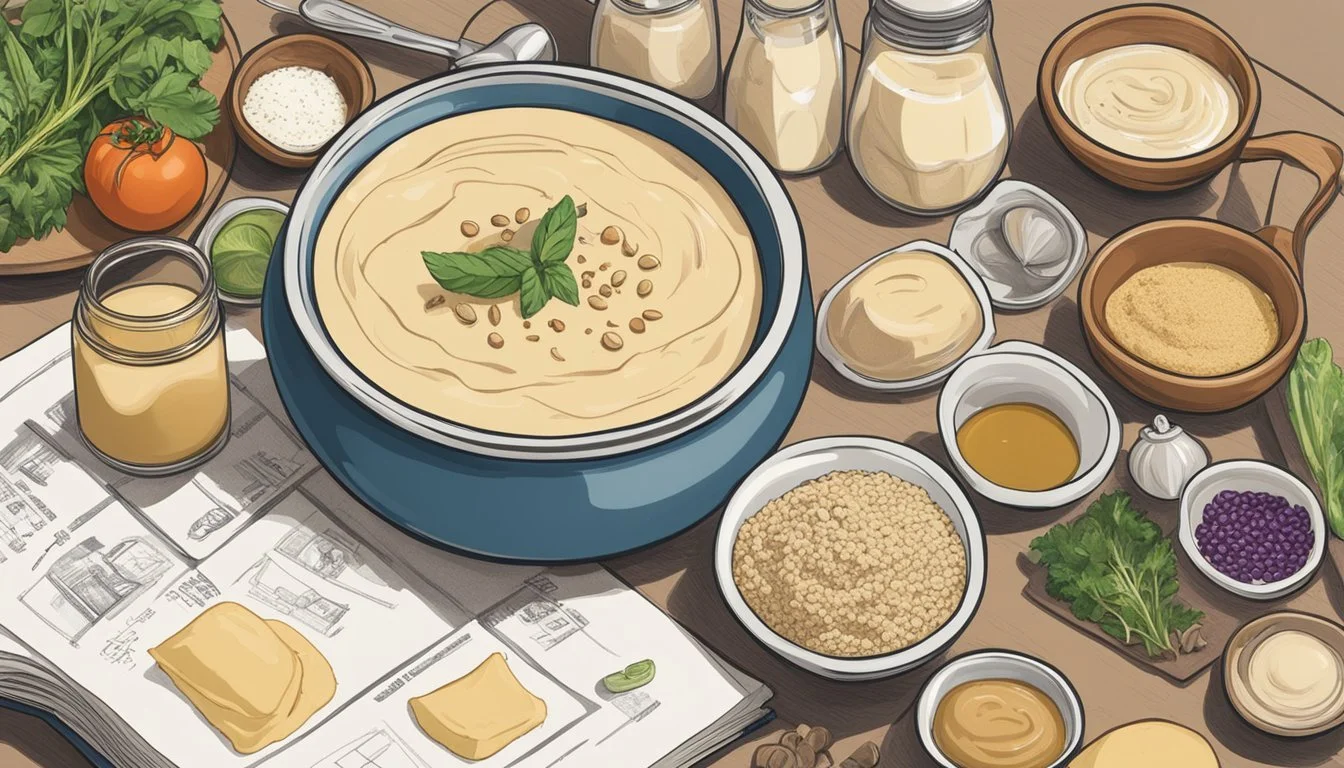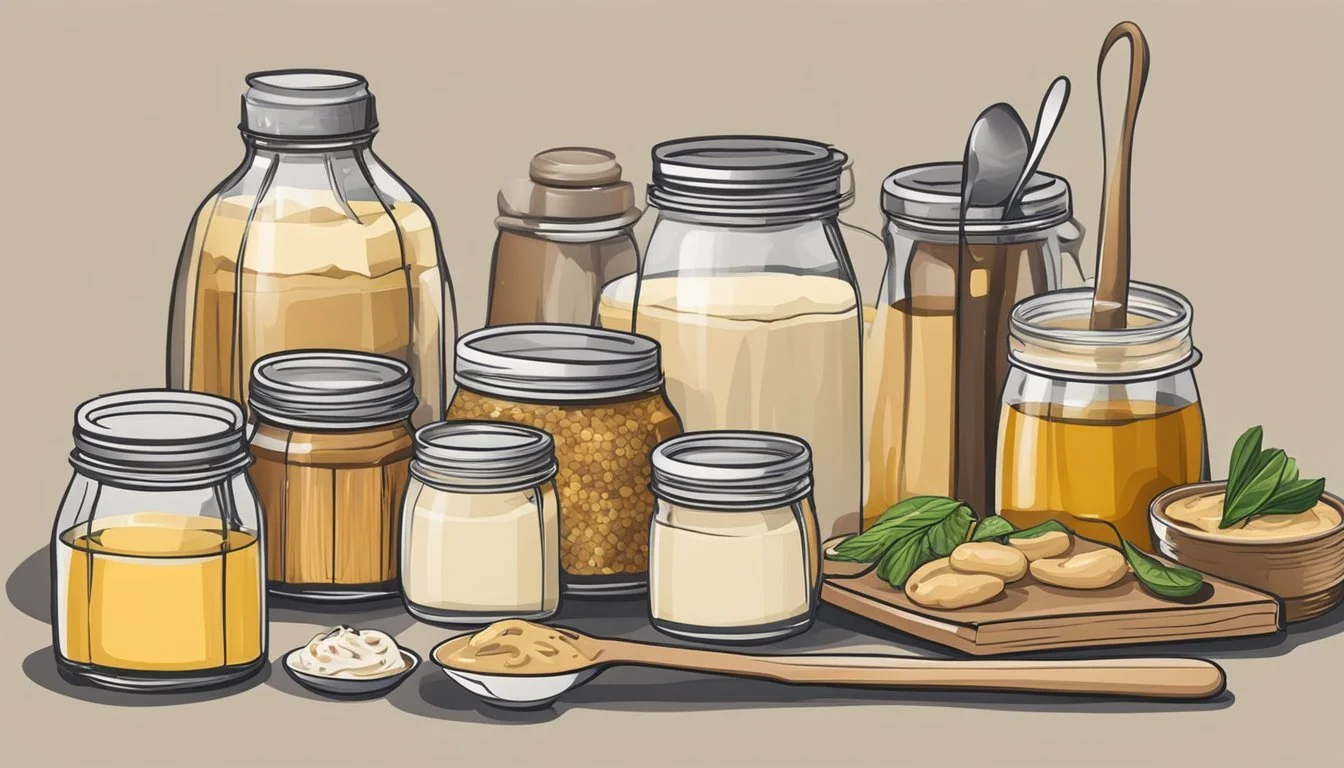How to Cook with Tahini Beyond Hummus
Exploring Versatile Uses in Your Kitchen
Tahini, a rich sesame paste, is no stranger to the culinary lexicon, especially within Middle Eastern cuisine where it serves as the creamy backbone to the popular dip, hummus. However, the versatility of tahini stretches far beyond this staple dish. Its nutty flavor and smooth, luxurious texture make it an excellent addition to a wide array of recipes. From main dishes to desserts, tahini can enhance flavors and add a depth that few other ingredients can match.
Chefs and home cooks alike are discovering that tahini's uses in the kitchen are as diverse as they are delicious. Its inherently gluten-free and vegan properties also make it a favorite among those with dietary restrictions. Whether it's whisked into dressings for a tangy twist, swirled into soups for added richness, or incorporated into sweet treats for a subtle complexity, tahini proves to be an indispensable ingredient.
In savory dishes, tahini complements the bright zing of citrus or the warmth of spices, adding a creamy consistency without the use of dairy. In desserts, it offers a bittersweet balance, working well with ingredients like chocolate or honey. As food enthusiasts continue to explore the potential of this sesame seed-based condiment, they find that its potential in the kitchen is as expansive as their own creativity.
The Basics of Tahini
In the culinary world, tahini is lauded for its versatility and nutritional content. This section explores what tahini is, its health benefits, and the nuances between homemade and store-bought versions.
What is Tahini?
Tahini is a creamy paste made from finely ground sesame seeds. These seeds are hulled and toasted, which amplifies their nutty flavor, before being blended into a smooth, rich substance. It's a staple in Middle Eastern and Mediterranean cuisines, functioning as a key ingredient in recipes beyond hummus.
Health Benefits of Tahini
As a concentrated form of sesame seeds, tahini is nutritious. It is a good source of healthy fats, calcium, and iron. Its health benefits include:
High in unsaturated fats: These are the 'good fats' which can support heart health.
Rich in minerals: Notably, tahini provides calcium for bone health and iron for blood health.
Contains antioxidants: These compounds help in protecting the body from oxidative stress.
Homemade Tahini vs. Store-Bought
Making tahini at home can be rewarding, with control over the texture and level of roast on the sesame seeds. Homemade tahini often has a fresher taste and allows for customizations in oil content and flavor. However, it requires processing power and time to achieve the desired smoothness.
Conversely, store-bought tahini offers convenience and a consistent product. It often has a longer shelf-life due to added preservatives. The choice between homemade and store-bought tahini may come down to personal preference and intended use in cooking.
Incorporating Tahini into Main Courses
Tahini's role extends well beyond hummus, acting as a versatile component in various main courses. Its nutty flavor and creamy texture make it a valuable addition to meat dishes, vegan and vegetarian entrees, as well as marinades and sauces.
Tahini in Meat Dishes
Chicken pairs exceptionally well with tahini, lending itself to the rich flavors of Middle Eastern cuisine. One can whisk tahini with lemon juice, garlic, and herbs to create a delectable sauce that complements the succulent texture of roasted or grilled chicken. Tahini can also be used to coat chicken before baking, which helps to lock in moisture and create a beautifully crisp exterior.
Example Tahini Chicken Recipe:
Rub chicken with a blend of tahini, olive oil, cumin, and paprika.
Roast until the skin is crispy and golden-brown.
Vegan and Vegetarian Entrees with Tahini
For vegan and vegetarian dishes (What wine goes well with vegetarian dishes?), tahini offers a satisfying richness. It makes an excellent dressing for roasted vegetables (What wine goes well with roasted vegetables?) or can be stirred into grain bowls to add depth. Falafel, a staple in Middle Eastern cuisine, is often served with a side of tahini sauce or dressing, which complements its spicy chickpea base.
Falafel Tahini Sauce:
Mix tahini with lemon juice, garlic, and water to desired consistency.
Drizzle over falafel or use as a dipping sauce.
Tahini-Based Marinades and Sauces
Tahini is not just a side dish companion; it can enhance entrees through marinades and sauces. It's an emulsifier and thickener, lending its distinct flavor to a variety of sauces from tangy to savory. By incorporating ingredients such as soy sauce, ginger, and honey, one can create a tahini-based marinade suitable for a range of dishes.
Simple Tahini Sauce Recipe:
Whisk together tahini, lemon juice, garlic, and water.
Use as a sauce for drizzling over meat or vegetables, or as a base for a more complex dressing.
With these applications, tahini proves itself as a transformative ingredient in main courses. Whether one is preparing a meat-centric dish, a vegan feast, or a quick yet flavorful marinade, tahini can take a meal from ordinary to extraordinary.
Creative Salads and Dressings
Tahini, a paste made from ground sesame seeds, is a versatile ingredient that not only enhances traditional Middle Eastern dishes but also brings creamy, nutty flavors to salads (What wine goes well with salads?) and dressings.
Boosting Salads with Tahini
Incorporating tahini into salads is an excellent way to add depth and creaminess without overpowering the fresh ingredients. For an Avocado and Carrot Salad, one may toss diced avocado and shredded carrots with a generous dollop of tahini. This creates a rich contrast to the crunchy vegetables and infuses the salad with a toasty sesame essence. Similarly, in a Cucumber Tomato Tahini Salad, the combination of tahini dressing with juicy tomatoes and crisp cucumber slices offers a delightful textural interplay. One can further tailor this salad by adding diced jalapenos and a sprinkle of Aleppo pepper for a hint of warmth.
Homemade Tahini Dressings
Tahini-based dressings are simple to prepare and can transform a plain salad into something extraordinary. A classic Lemon Tahini Sauce involves whisking together tahini, fresh lemon juice, garlic, and water until smooth. This zesty dressing pairs beautifully with mixed greens or a chickpea salad.
For those seeking a bold flavor, a Garlic Tahini Sauce can be created by blending tahini with garlic cloves, olive oil, and a pinch of salt until the flavors amalgamate. This dressing is particularly delicious when drizzled over roasted vegetables or a grain-based salad.
By experimenting with tahini in salads and dressings, one can find numerous ways to enhance a variety of dishes with its unique, nutty flavor.
Tahini-Infused Snacks and Dips
Tahini's versatility extends far beyond its staple role in hummus. As a plant-based ingredient, tahini can elevate the simplest of snacks and dips with its creamy texture and rich, nutty flavor.
Tahini as a Dip for Vegetables and More
Tahini makes an excellent dip base that complements the freshness of raw vegetables. To prepare tahini as a dip, one can simply mix it with lemon juice, garlic, and herbs, adjusting the consistency with water as needed. This dip not only pairs well with traditional crudité but also with pita bread and chips, offering a nutritious alternative for vegan diners.
Example Dip Recipe:
Ingredients:
1/2 cup tahini
2 tablespoons lemon juice
1 garlic clove, minced
Salt and pepper to taste
Water to thin
Instructions:
In a small bowl, whisk together tahini and lemon juice.
Add the minced garlic, salt, and pepper, blending them into the mix.
Gradually add water until desired consistency is reached.
Dip Pairings:
Sliced cucumbers
Carrot sticks
Bell pepper strips
Warm pita slices
Whole grain crackers
Whipped Tahini Snacks
Whipped tahini is a lighter, fluffier alternative to traditional tahini dips, thanks to the addition of air during the whipping process. One can introduce additional flavors such as maple syrup or vanilla extract to make sweet whipped spreads for fruit slices or toast. Perfect as a light midday snack, these whipped tahini creations are a testament to tahini's adaptability in various culinary contexts.
Example Whipped Tahini Spread:
Ingredients:
1 cup tahini
2 teaspoons honey or maple syrup
A pinch of salt
Instructions:
Place tahini in a mixing bowl and add sweetener and salt.
Use a hand mixer to whip the mixture until it is light and airy.
Bold flavors and whole-food ingredients transform the unassuming sesame paste into centerpieces of the snack table. Whether one sticks to savory garlic-infused spreads for vegetables or ventures into the sweet realm with honey-whipped delights, tahini offers a plethora of possibilities for snack-time innovation.
Using Tahini in Soups and Stews
Tahini can enhance soups and stews by contributing a rich, creamy texture without the need for dairy. Its nutty flavor profile adds depth and compliments a variety of ingredients.
Adding Creaminess without Dairy
Incorporating tahini into soups and stews is a clever way to achieve a creamy consistency without the use of traditional dairy products, making it an excellent choice for those who are lactose-intolerant or following a vegan diet. To effectively use tahini in this context, one should whisk the tahini in a separate bowl with a small amount of the warm broth until smooth and then gradually add it back into the pot. This helps prevent clumping and ensures an even distribution. A ratio of one to three tablespoons of tahini per quart of liquid usually suffices to impart noticeable creaminess.
Step-by-Step Creaminess:
Whisk 1-3 tablespoons of tahini with a small amount of warm broth until smooth.
Gradually stir the mixture back into your soup or stew.
Adjust the ratio to achieve desired creaminess.
Tahini-Themed Soup Variations
Tahini isn't just for adding texture; it serves as a foundational flavor for certain soup recipes. A carrot-tahini soup elegantly combines earthy spices like coriander and turmeric with the nuttiness of tahini, often brightened with a squeeze of lemon juice. Similarly, a lemon-tahini chicken soup incorporates a tahini and lemon juice mixture, zesting up traditional chicken soup into a more complex taste experience.
Example Flavors & Ingredients:
Carrot-Tahini Soup: Garlic, coriander, turmeric, and lemon.
Lemon-Tahini Chicken Soup: Orzo, chicken broth, and a dash of hot sauce.
Side Dishes with a Tahini Twist
Tahini's versatility extends well into the realm of side dishes. It can elevate the humblest of vegetables and grains with its rich, nutty flavor, transforming them into sophisticated complements to any main course.
Roasted Vegetables with Tahini Glaze
Roasted cauliflower: Cauliflower florets become a canvas for flavors when roasted until golden. A glaze made from tahini mixed with a touch of honey, garlic, and lemon juice can be drizzled over the warm cauliflower, offering a delightful contrast of creaminess to the crisp edges. This side dish is not only flavorful but also gluten-free and dairy-free, catering to a variety of dietary needs.
Protein Bonus: To make the dish more substantial, one might consider adding chickpeas during the roasting process. They add a protein boost, making the side dish more filling.
Grains and Legumes Enhanced by Tahini
Quinoa Salad: Introduce tahini into your grain salads for an unexpected depth of flavor. For example, a quinoa salad dressed with a lemon-tahini vinaigrette brings zest and richness to the nutty profile of the quinoa, which is naturally gluten-free.
Legumes: Lentils or black beans can be stirred into the mix for added protein, fiber, and texture. Adding sliced vegetables such as bell peppers or cucumbers offers a crispness that balances the creamy quality of the tahini dressing.
Baking and Desserts
Tahini, a paste made from ground sesame seeds, brings a rich, nutty flavor to baked goods and desserts, transforming the familiar into something intriguingly unique. Its versatility complements both sweet and savory ingredients, offering a nutritionally richer alternative to traditional fats used in baking.
Tahini-Infused Baked Goods
When one adds tahini to traditional baking recipes, it imparts a depth of flavor and a moist texture. Chocolate chip cookies and brownies benefit greatly from tahini's presence. It not only replaces some of the fat content traditionally fulfilled by butter but also elevates the taste profile. For instance, salted tahini chocolate chip cookies become irresistible with their complex flavor profile—salty and sweet notes intertwined.
Recipe Adjustment: To incorporate tahini into cookies, one typically replaces half the amount of butter with tahini.
Texture: Expect a tender crumb in cookies and a fudgy texture in brownies when tahini is used.
Flavor Enhancement: For chocolate-based recipes like brownies, try adding a tablespoon or two of cocoa powder to complement the nuttiness of tahini.
Tahini-Flavored Desserts
Beyond baked goods, tahini serves as a foundational element in various desserts, offering nutritious richness. It's a star ingredient in frozen treats such as popsicles, where it harmonizes with fruits and spices, like vanilla, to produce creamy and satisfying flavors. The dessert category is broad; tahini can elevate simple dishes into gourmet experiences.
Diversity in Desserts: Mix tahini with ingredients like avocado, soy milk, and chocolate syrup to create vegan-friendly dessert options.
Serving Tip: Enhance your finished dessert with garnishes like sesame seeds or chopped toasted hazelnuts for added texture and visual appeal.
Utilizing tahini in baking and desserts not only contributes a twist of flavor but also infuses dishes with sesame's nutritional benefits.
Condiments and Tahini Enhancements
Tahini, with its rich, nutty flavor, serves as the perfect base for various condiments and is a versatile enhancer for many dishes when drizzled in its pure form.
Tahini-Based Condiments
A well-crafted tahini-based condiment, combining ingredients like lemon, garlic, and sometimes honey or maple syrup, can elevate the simplest dishes. They present a balance of flavors that range from tangy to sweet while maintaining tahini's distinct taste.
Chipotle Tahini Sauce: Integrating tahini with olive oil, salt, chipotle peppers, garlic, and orange juice creates a bold, zesty sauce that complements roasted vegetables and grilled meats.
Tahini Ranch: By blending tahini with traditional ranch seasonings alongside a touch of honey, one gets a creamy, tangy condiment that pairs well with salads or as a dip for crudités.
Enhancing Dishes with a Drizzle of Tahini
A simple drizzle of tahini can enhance a variety of dishes, adding a creamy texture and a depth of flavor.
On Soups: A dash of tahini atop a velvety soup provides a contrast in textures and a nutty undertone that complements base ingredients like asparagus or squash.
Over Avocado Cobb Salad: Drizzling tahini over a cobb salad with sundried tomatoes and avocado adds a creamy dressing aspect without overshadowing the freshness of the salad ingredients.
Tahini in Specialty Diets
Tahini serves as a versatile ingredient that effortlessly integrates into various specialty diets, providing a blend of rich flavor and nutritious benefits suitable for vegan, gluten-free, keto, and paleo eating patterns. Often used as a substitute for nut butters, tahini is a dairy-free option that enhances dishes while adhering to dietary restrictions.
Tahini in Vegan and Gluten-Free Cooking
In vegan cooking, tahini is an essential staple, not just for its flavor but as an excellent source of calcium and protein. Vegan chefs incorporate it into dressings, sauces, and even desserts, ensuring that dishes maintain a creamy texture without the use of dairy. As a naturally gluten-free seed butter, tahini is also safe for those with celiac disease or gluten sensitivity. It can act as a binding agent in gluten-free baking, adding moisture and richness to breads and cookies.
Vegan Recipes:
Salad dressings: Mix tahini with lemon juice and herbs.
Dairy-free desserts: Use as a base for vegan cheesecake.
Gluten-Free Applications:
Baking substitute: Replace nut butters in recipes.
Soup thickener: Add to soups for a creamy texture without flour.
Keto and Paleo Friendly Options with Tahini
For those following keto or paleo diets, tahini is an ally due to its high fat, low carb profile. Its use in recipes can help achieve the required fat intake for keto diets while avoiding dairy and grains, which are restricted in paleo plans. It's an ideal component in dips and spreads or as a flavor enhancer in main courses, where one might usually use dairy-based or sugary sauces.
Keto Diet Emphasis:
Fat boost: Incorporate into smoothies and shakes.
Paleo Diet Uses:
Grain-free sauces: Create tahini-based sauces for meats and vegetables.
Kitchen Tips and Techniques
In utilizing tahini beyond hummus, proper storage and mastering cooking methods can significantly enhance its flavor and shelf life. This section offers practical advice on how to keep tahini fresh and integrate it effectively into various dishes.
Storing and Preserving Tahini
One should store tahini in an airtight container to prevent it from going rancid. Keeping tahini in the fridge after opening prolongs its freshness, but one can also keep it in a pantry if it's used frequently and within a short timespan. To prevent separation, one might occasionally stir the tahini, maintaining its smooth consistency.
Cooking Methods and Best Practices
When cooking with tahini, incorporating it into recipes using a blender or food processor can yield a smooth and even texture. Applying gentle heat can help integrate tahini into sauces or soups effectively; be cautious not to overheat, as this can result in bitterness. For optimal flavor, tahini should be added to the cooking process at the right stage—typically towards the end for hot dishes or combined with complementary ingredients such as lemon juice or olive oil when used in dressings and marinades.








